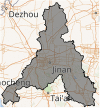The Effects of Ambient Temperature on Lumbar Disc Herniation: A Retrospective Study
- PMID: 35928296
- PMCID: PMC9343687
- DOI: 10.3389/fmed.2022.811237
The Effects of Ambient Temperature on Lumbar Disc Herniation: A Retrospective Study
Abstract
Purpose: This article was designed to provide critical evidence into the relationship between ambient temperature and intensity of back pain in people with lumbar disc herniation (LDH).
Methods: Data concerning patient's age, gender, diagnostic logout, admission time, discharge time, residence area, and work area (residence area and work area were used to ensure research area) from 2017 to 2019 were obtained from the Neck-Shoulder and Lumbocrural Pain Hospital in Jinan, China. A total of 1,450 hospitalization records were collected in total. The distributed lag non-linear model (DLNM) was used to evaluate the relationship between lag-response and exposure to ambient temperature. Stratification was based on age and gender. Days 1, 5, 20, and 28 prior to admission were denoted as lags 0, 5, 20, and 28, respectively.
Results: An average daily temperature of 15-23°C reduced the risk of hospitalization the most in men. Conversely, temperatures <10°C drastically increased hospitalization in men, particularly in lags 0-5 and lags 20-28. Men aged between 40 and 50 years old showed less effect in pain sensation during ambient temperature.
Conclusion: High or low ambient temperature can increase the hospitalization risk of LDH, and sometimes, the temperature effect is delayed.
Keywords: ambient temperature; chronic disease; distributed lag linear and non-linear models; low back pain; lumbar disc herniation; unhealthy habits.
Copyright © 2022 Wang, Chen, Liu, Bu, An, Qin, Zhang, Wang, Cao, Li and Shi.
Conflict of interest statement
The authors declare that the research was conducted in the absence of any commercial or financial relationships that could be construed as a potential conflict of interest.
Figures








Similar articles
-
Short-term effects of ambient temperature on the risk of preeclampsia in Nanjing, China: a time-series analysis.BMC Pregnancy Childbirth. 2022 Jul 4;22(1):539. doi: 10.1186/s12884-022-04859-w. BMC Pregnancy Childbirth. 2022. PMID: 35787682 Free PMC article.
-
Adolescent lumbar disc herniation: experience from a large minimally invasive treatment centre for lumbar degenerative disease in Chongqing, China.Clin Neurol Neurosurg. 2013 Aug;115(8):1415-9. doi: 10.1016/j.clineuro.2013.01.019. Epub 2013 Feb 16. Clin Neurol Neurosurg. 2013. PMID: 23419406
-
Short-term effect of ambient temperature change on the risk of tuberculosis admissions: Assessments of two exposure metrics.Environ Res. 2020 Oct;189:109900. doi: 10.1016/j.envres.2020.109900. Epub 2020 Jul 12. Environ Res. 2020. PMID: 32980000
-
Effects of ambient temperature on daily hospital admissions for mental disorders in Shanghai, China: A time-series analysis.Sci Total Environ. 2017 Jul 15;590-591:281-286. doi: 10.1016/j.scitotenv.2017.02.237. Epub 2017 Mar 6. Sci Total Environ. 2017. PMID: 28274603
-
The association between ambient temperature and mortality of the coronavirus disease 2019 (COVID-19) in Wuhan, China: a time-series analysis.BMC Public Health. 2021 Jan 11;21(1):117. doi: 10.1186/s12889-020-10131-7. BMC Public Health. 2021. PMID: 33430851 Free PMC article.
Cited by
-
Development and validation of a predictive model and tool for functional recovery in patients after postero-lateral interbody fusion.J Orthop Surg Res. 2025 Jan 10;20(1):38. doi: 10.1186/s13018-024-05353-z. J Orthop Surg Res. 2025. PMID: 39794809 Free PMC article.
References
LinkOut - more resources
Full Text Sources

